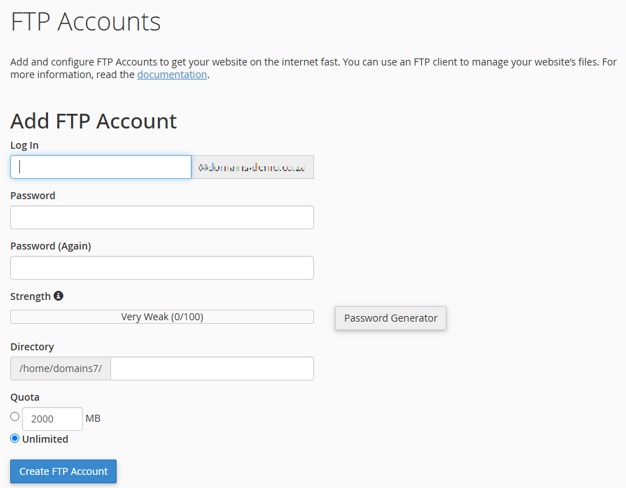Learn how to find FTP details in cPanel. FTP (File Transfer Protocol)details allows you to upload, download, and manage website files directly between your computer and your web server. To connect via an FTP client such as FileZilla, you’ll need specific login credentials, including your FTP hostname, username, and password.
With web hosting from Domains.co.za, finding your FTP details in cPanel is fast and simple, giving you full control over your website’s file system.
TABLE OF CONTENTS
How to Find FTP Details in cPanel
This article assumes that you have already logged into your Domains.co.za Account and have accessed the cPanel Dashboard – refer below for steps on how to do this.
Follow these steps to locate your FTP login information:
Navigate to FTP Details Accounts
1. Scroll to Files and click FTP Accounts.

2. Here you will see a list of existing FTP accounts:
- FTP Username: Listed under Logins.
- FTP Server / Hostname: Typically, your domain name (e.g., ftp.yourdomain.co.za) or the server’s IP address (found under General Information in cPanel).
- Port: Standard FTP uses port 21. For secure FTP (FTPS), you can use port 990.
How to Change FTP Details Password
3. To view or reset the password:
- Click Change Password next to an FTP account.

How to Create a FTP Details New Account
Note: You can also create a new FTP account if necessary, by filling out the form at the top of the FTP Accounts page.
Additional Information
What You Can Do with FTP
Upload website files from your local machine. It also allows you to download site backups or logs, while being able to edit, delete, or organise website content efficiently.
FTP vs File Manager
File Manager (in cPanel) is great for quick edits and uploads directly in your browser. FTP is better for large file uploads, drag-and-drop transfers, or batch editing with external tools
FTP General Information
- Default FTP Account: Your cPanel main account also acts as the default FTP user. It uses the cPanel login credentials and points to the root directory.
- Creating Additional FTP Users: You can create users with restricted access to specific directories, great for teams or developers working on specific parts of your website.
- Security Best Practice: Use FTPS (FTP over TLS) for encrypted connections and regularly change FTP passwords. Also, disable unused FTP accounts to reduce risks.
- Firewall Note: If you’re connecting from a private network, ensure that port 21 or 990 is open and not blocked by your firewall.
Login to Domains.co.za Account
1. Go to the Domains.co.za Login website page.

2. Enter your Email and Password and click the “Sign In” button.
3. You will see the Domains.co.za Dashboard, displaying the Manage Account menu on the left and your Account Information, Account Overview and Open Support Tickets on the right.

Login to cPanel from Your Domains.co.za Dashboard
4. Click on Manage Services to view the sub-dropdown menu and select the hosting package for the domain you want to work with – in our example we are using Web Hosting.

5. Click the Manage button to the right of the domain name you want to access.
6. The display will now show Product Information, Quick Manage, Resource Usage and Site Statistics for that domain name.

7. Under Product Information, scroll down to Control Panel, which will display cPanel to the right, and click on the Login button.

8. The cPanel Dashboard will now be displayed.




